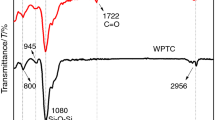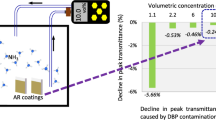Abstract






Similar content being viewed by others
References
Riede W, Allenspacher P, Schröder H, Wernham D, Lien Y (2005) Laser-induced hydrocarbon contamination in vacuum, p 59910H
Jensen L, Jupe M, Madebach H, Ehlers H, Starke K, Ristau D et al (2006) Damage threshold investigations of high-power laser optics under atmospheric and vacuum conditions, 6403:64030U-U-10
Pareek R, Kumbhare MN, Mukherjee C, Joshi AS, Gupta PD (2008) Effect of oil vapor contamination on the performance of porous silica sol–gel antireflection-coated optics in vacuum spatial filters of high-power neodymium glass laser. Opt Eng 47:023801
Ling X, Zhao Y, Li D, Li S, Zhou M, Shao J et al (2009) Impact of organic contamination on the laser-induced damage in vacuum. Appl Surf Sci 255:9255–9258
Yun C, Shi-Jie L, Hong-Bo H, Yuan-An Z, Jian-Da S, Zheng-Xiu F (2007) Influence of vacuum organic contaminations on laser-induced damage of 1064 nm anti-reflective coatings. Chin Phys Lett 24:2873
Li X, Shen J (2011) The stability of sol–gel silica coatings in vacuum with organic contaminants. J Sol–Gel Sci Technol 59:539–545
Sun J, Wu B, Jia H, Wu D, Xu Y (2012) Fluoroalkyl-grafted mesoporous silica antireflective films with enhanced stability in vacuum. Opt Lett 37:4095–4097
Ling B, He H, Shao J (2007) Effects of water vapor in high vacuum chamber on the properties of HfO2 films. Chin Opt Lett 5:487–489
Ling X, Zhao Y, Shao J, Fan Z (2010) Effect of two organic contamination modes on laser-induced damage of high reflective films in vacuum. Thin Solid Films 519:296–300
Cui Y, Zhao Y, Yu H, He H, Shao J (2008) Impact of organic contamination on laser-induced damage threshold of high reflectance coatings in vacuum. Appl Surf Sci 254:5990–5993
Thomas IM, Burnham AK, Ertel J, Frieders S (1999) Method for reducing the effect of environmental contamination of sol–gel optical coatings. p 220
Wang X, Shen J (2011) A review of contamination-resistant antireflective sol–gel coatings. J Sol–Gel Sci Technol 61:206–212
Bien-Aimé K, Pereira A, Belin C, Gallais L, Grua P, Tovena-Pecault I et al (2009) Impact of outgassing organic contamination on laser-induced damage of optics. p 75040V
Guéhenneux G, Bouchut P, Veillerot M, Pereira A, Tovena I (2005) Impact of outgassing organic contamination on laser-induced damage threshold of optics: effect of laser conditioning. p 59910F
Xu Y, Wu D, Sun YH, Li ZH, Dong BZ, Wu ZH (2005) Comparative study on hydrophobic anti-reflective films from three kinds of methyl-modified silica sols. J Non Cryst Solids 351:258–266
Floch H, Belleville P (1994) A scratch-resistant single-layer antireflective coating by a low temperature sol–gel route. J Sol–Gel Sci Technol 1:293–304
Thomas IM (1992) Effect of binders on the damage threshold and refractive index of coatings prepared from colloidal suspensions. Laser Induc Damage Opt Mater 1:281–289
Xu Y, Zhang B, Hao Fan W, Wu D, Han Sun Y (2003) Sol–gel broadband anti-reflective single-layer silica films with high laser damage threshold. Thin Solid Films 440:180–183
Sermon PA, Vong MS, Bazin NJ, Badheka R, Spriggs D (1995) Recent developments in silica sol–gel antireflection (AR) coatings. In: Proceedings of solid state lasers for application to inertial confinement fusion (ICF): International Society for Optics and Photonics, pp 464–74
Tian H, Xu Y, Wu D, Wu ZH, Hai-Bing L, Yuan XD (2012) Comparision of silica anti-reflective films obtained emvia/em a sol–gel process in the presence of PEG or PVP. Acta Phys-Chimica Sinica 28:1197–1205
Xu Y, Fan WH, Li ZH, Wu D, Sun YH (2003) Antireflective silica thin films with super water repellence via a sol–gel process. Appl Opt 42:108–112
Philipavičius J, Kazadojev I, Beganskienė A, Melninkaitis A, Sirutkaitis V, Kareiva A (2008) Hydrophobic antireflective silica coatings via sol–gel process. Mater Sci 14:283–287
Su D, Huang C, Hu Y, Jiang Q, Zhang L, Zhu Y (2011) Preparation of superhydrophobic surface with a novel sol–gel system. Appl Surf Sci 258:928–934
Marshall KL, Culakova Z, Ashe B, Giacofei C, Rigatti AL, Kessler TJ et al. (2007) Vapor-phase-deposited organosilane coatings as hardening agents for high-peak-power laser optics. 6674: 667407–667411
ISO 11254-1:2000, Lasers and laser-related equipment—determination of laser-induced damage threshold of optical surfaces—Part 1: 1-on-1 test
Bom M, Wolf E (1980) Principles of optics, vol 19891. Pergamon, New York, pp 747–754
Nakajima A, Abe K, Hashimoto K, Watanabe T (2000) Preparation of hard super-hydrophobic films with visible light transmission. Thin Solid Films 376:140–143
Tadanaga K, Morinaga J, Matsuda A, Minami T (2000) Superhydrophobic-superhydrophilic micropatterning on flowerlike alumina coating film by the sol–gel method. Chem Mater 12:590–592
Ogawa K, Soga M, Takada Y, Nakayama I (1993) Development of a transparent and ultrahydrophobic glass plate. Jpn J Appl Phys 32:L614–L615
Li X, Gross M, Green K, Oreb B, Shen J (2012) Ultraviolet laser-induced damage on fused silica substrate and its sol–gel coating. Opt Lett 37:2364–2366
Li X, Gross M, Oreb B, Shen J (2012) Increased laser-damage resistance of sol–gel silica coating by structure modification. J Phys Chem C 116:18367–18371
Almeida RM, Pantano CG (1990) Structural investigation of silica gel films by infrared spectroscopy. J Appl Phys 68:4225–4232
Innocenzi P (2003) Infrared spectroscopy of sol–gel derived silica-based films: a spectra-microstructure overview. J Non Cryst Solids 316:309–319
Latthe SS, Imai H, Ganesan V, Kappenstein C, Rao AV (2009) Optically transparent superhydrophobic TEOS-derived silica films by surface silylation method. J Sol–Gel Sci Technol 53:208–215
Acknowledgments
This work is supported by the National Natural Science Foundation of China (11074189, U1230113), National Key Technology Research and Development Program of China (2013BAJ01B01).
Author information
Authors and Affiliations
Corresponding author
Rights and permissions
About this article
Cite this article
Liu, Y., Shen, J., Zhou, B. et al. Effect of hydrophobicity on the stability of sol–gel silica coatings in vacuum and their laser damage threshold. J Sol-Gel Sci Technol 68, 81–87 (2013). https://doi.org/10.1007/s10971-013-3137-z
Received:
Accepted:
Published:
Issue Date:
DOI: https://doi.org/10.1007/s10971-013-3137-z




